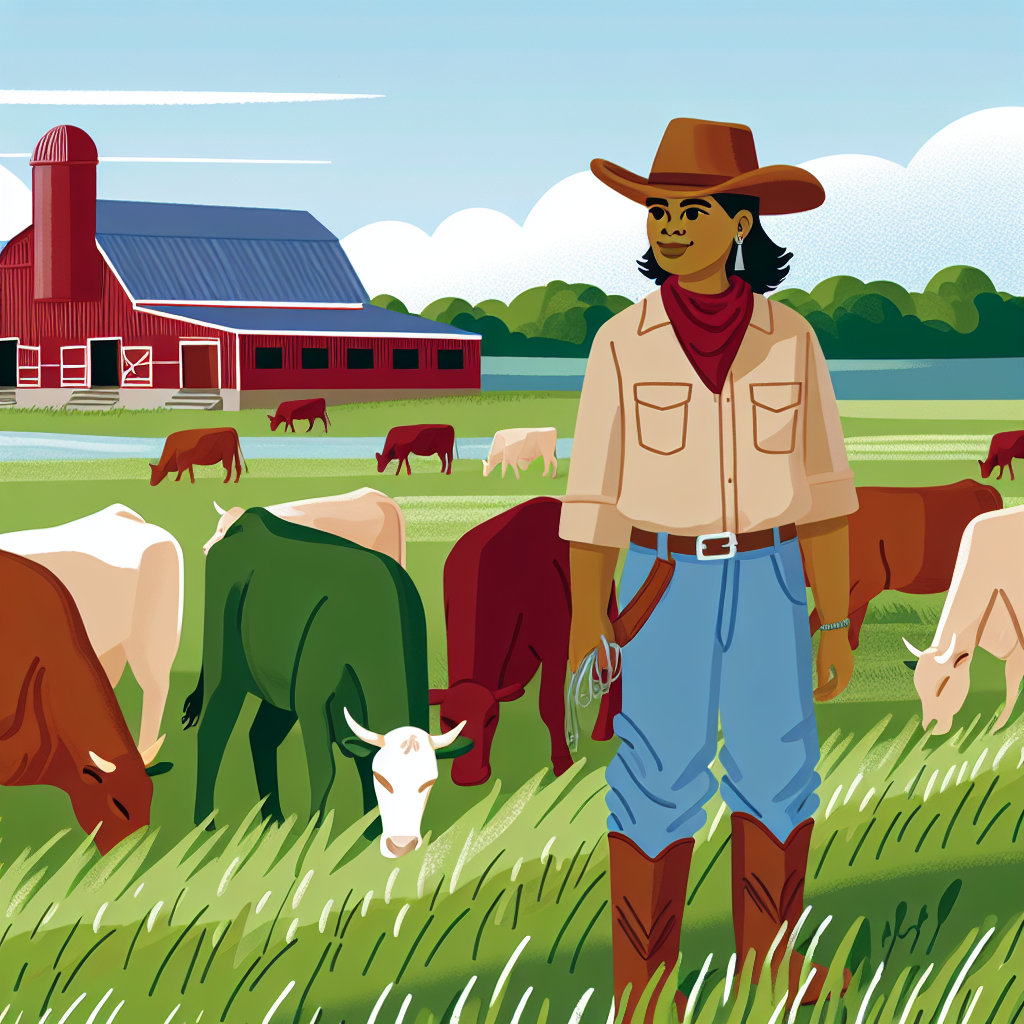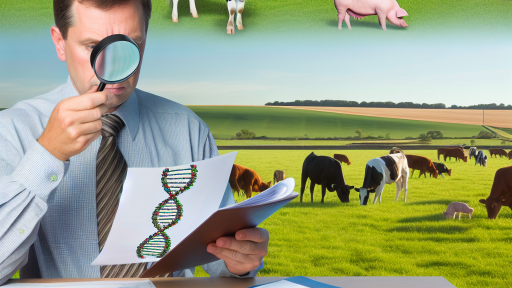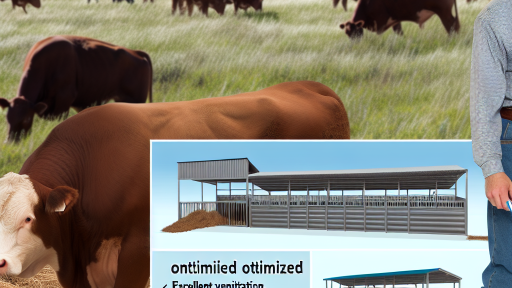Understanding Natural Health Management
Core Principles
Natural health management emphasizes holistic care for beef cattle.
It focuses on prevention rather than treatment of diseases.
By enhancing the immune system, cows remain healthier overall.
This management approach utilizes natural resources and processes.
Moreover, it promotes animal welfare and reduces stress.
Practices in Natural Health Management
Farmers should prioritize nutrition in their cattle’s diet.
A well-balanced diet boosts immunity and productivity.
Access to clean water is essential for overall health.
Regular exercise helps maintain physical fitness in cattle.
Furthermore, farmers can incorporate rotational grazing techniques.
This practice improves pasture health and diversity.
Preventive Healthcare Approaches
Vaccinations play a crucial role in preventing diseases.
Routine health checks should be established for each herd.
These checks enable early disease detection and management.
Furthermore, biosecurity measures help prevent disease spread.
Transform Your Agribusiness
Unlock your farm's potential with expert advice tailored to your needs. Get actionable steps that drive real results.
Get StartedFarmers should implement strict protocols on their farms.
Monitoring and Evaluation
Consistent monitoring of cattle health is vital.
Farmers can track weight, growth rates, and behavioral changes.
Such evaluations help in assessing the effectiveness of practices.
Adjustments can be made according to observed health trends.
Additionally, record-keeping supports informed decision-making.
Nutritional Strategies for Optimal Beef Cattle Health
Importance of Balanced Diet
A balanced diet is crucial for beef cattle health.
Nutrients contribute to growth, reproduction, and overall well-being.
Inclusion of proteins, carbohydrates, fats, vitamins, and minerals is essential.
Quality Forage Selection
Selecting high-quality forage benefits cattle nutrition.
Legumes and grasses can enhance protein intake.
Additionally, fresh and clean forage promotes better digestion.
Cattle thrive on perennial pastures that are well-managed.
Supplementation Strategies
Supplementation can address nutrient deficiencies in the diet.
Consider adding minerals such as calcium and phosphorus.
Vitamins like A, D, and E are important for healthy growth.
Moreover, specific amino acids can enhance muscle development.
Utilizing Feed Additives
Feed additives can improve cattle health and productivity.
Probiotics enhance gut health and nutrient absorption.
Meanwhile, enzymes can help break down fibrous feeds efficiently.
Furthermore, antioxidants support immune response in beef cattle.
Monitoring Body Condition
Regularly monitoring body condition is vital for nutritional management.
Body condition scoring helps assess cattle health status.
Adjusting feeds based on this evaluation promotes optimal growth.
Showcase Your Farming Business
Publish your professional farming services profile on our blog for a one-time fee of $200 and reach a dedicated audience of farmers and agribusiness owners.
Publish Your ProfileThis strategy also aids in preventing over-conditioning or under-conditioning.
Hydration Considerations
Access to clean and fresh water is critical for beef cattle.
Water intake directly affects feed consumption and digestion.
Heating or freezing conditions can impact hydration levels.
Therefore, ensure water sources are consistently available.
The Role of Pasture Management in Disease Prevention
Importance of Pasture Quality
Pasture quality directly influences cattle health and vitality.
A diverse plant composition promotes a balanced diet for the animals.
Healthy pastures reduce stress on cattle, leading to lower disease rates.
High-quality forage supports immune function and overall performance.
Maintaining Soil Health
Soil health impacts pasture growth and sustainability.
Regular soil testing informs necessary amendments for nutrient balance.
Crop rotation enhances soil structure and fertility over time.
Incorporating cover crops prevents erosion and builds organic matter.
Pasture Rotation Techniques
Implementing rotational grazing minimizes overgrazing and compaction.
This technique allows pastures to recover and regenerate effectively.
Healthy recovery leads to improved plant diversity and resilience.
Moreover, it helps break the life cycles of certain parasites.
Monitoring and Assessment
Regular monitoring facilitates timely interventions in pasture health.
Assessing plant growth helps identify foraging patterns in cattle.
Keeping records of pasture conditions aids in future planning.
Effective management practices evolve based on monitoring results.
Reducing Disease Exposure
Well-managed pastures provide ample space for cattle to roam.
Spacing reduces stress and lowers the risk of disease transmission.
Maintaining cleanliness in water sources further supports health.
Access to clean water encourages hydration and overall well-being.
Integrating Wildlife Management
Understanding wildlife interactions can minimize disease risks.
Proper fencing limits wildlife access to grazing areas.
Monitoring wildlife populations helps assess potential disease threats.
Additionally, creating buffer zones protects cattle from wildlife exposure.
Gain More Insights: Seasonal Care Tips for Exotic Animals
Integrating Herbal Remedies
Benefits of Herbal Supplements
Herbal supplements enhance the health and productivity of beef cattle.
These remedies offer natural alternatives to synthetic substances.
Additionally, they support immune function and digestive health.
Moreover, many herbal remedies help reduce stress in cattle.
Commonly Used Herbs in Beef Cattle Management
Several herbs are popular among ranchers for their health benefits.
- Garlic boosts immunity and reduces parasites.
- Milk thistle aids liver health and detoxification.
- Alfalfa provides essential nutrients and improves digestion.
- Ginger enhances appetites and supports digestive health.
Each of these herbs plays a unique role in cattle care.
Application Methods for Herbal Remedies
Herbal remedies can be administered in various forms.
- Powders can be mixed into feed for easy consumption.
- Tinctures can be added to water for hydration.
- Dried herbs can be sprinkled over hay for added nutrition.
These methods ensure that cattle receive the benefits of herbal supplementation.
Considerations When Using Herbal Remedies
When using herbal remedies, it’s crucial to consult a veterinarian.
Each remedy may interact differently with individual cattle health.
Showcase Your Farming Business
Publish your professional farming services profile on our blog for a one-time fee of $200 and reach a dedicated audience of farmers and agribusiness owners.
Publish Your ProfileMoreover, careful dosage is essential to avoid adverse effects.
Keep records of any changes in cattle health or productivity.
Regular monitoring will help ensure positive outcomes.
Explore Further: Cost-Effective Exotic Livestock Management
Disease Prevention through Vaccination and Natural Resistance
The Importance of Vaccination
Vaccination plays a crucial role in cattle health management.
It protects beef cattle from various infectious diseases.
Implementing a proper vaccination schedule is essential.
Regular vaccinations can significantly reduce disease outbreaks.
Moreover, vaccinated animals exhibit fewer health complications.
Types of Vaccines Available
Several types of vaccines are available for beef cattle.
Modified-live vaccines stimulate a strong immune response.
Killed vaccines are safer but may require boosters.
Consulting with a veterinarian helps choose the right vaccine.
The Role of Natural Resistance
Natural resistance enhances disease prevention in cattle.
Genetics significantly influence an animal’s immune system.
For example, some breeds show better disease resistance.
Improving herd genetics can lead to healthier cattle.
Enhancing Natural Resistance through Nutrition
Nutritional management is vital for natural resistance.
Providing a balanced diet boosts the immune system.
Essential vitamins and minerals support overall health.
High-quality forage improves gut health and digestion.
Monitoring and Management Practices
Regular health monitoring helps identify health issues early.
Maintaining a clean environment reduces pathogen exposure.
Implementing biosecurity measures protects against infections.
Educating staff on disease signs aids in prompt intervention.
Learn More: Managing Goat Behavior on the Farm

Holistic Approaches to Stress Management in Beef Cattle
Understanding Cattle Stress
Cattle experience stress from various sources.
Common stressors include weather, handling, and nutrition.
Recognizing these stressors is the first step.
Effective stress management improves overall herd health.
Environmental Enrichment
Environmental enrichment enhances cattle well-being.
Providing adequate space reduces competition among animals.
Shelter from harsh weather is crucial.
Additionally, varied feed sources promote natural behaviors.
Gentle Handling Practices
Using low-stress handling techniques greatly benefits cattle.
Trained handlers create a calm environment.
Moving cattle slowly helps minimize anxiety.
Positive interactions build trust between handlers and cattle.
Nutritional Management
A balanced diet plays a vital role in stress reduction.
Well-nourished cattle are less susceptible to stress.
Showcase Your Farming Business
Publish your professional farming services profile on our blog for a one-time fee of $200 and reach a dedicated audience of farmers and agribusiness owners.
Publish Your ProfileConsider incorporating supplements for specific nutritional needs.
Regularly review feed quality to ensure optimal health.
Regular Health Assessments
Routine health assessments are essential for early detection.
Monitoring body condition scores helps identify undernourished cattle.
Regular vaccinations prevent disease-related stress.
Consult a veterinarian for comprehensive health strategies.
Social Structure and Herd Dynamics
Cattle are social animals and thrive in stable groups.
Disruptions in herd dynamics can cause stress.
Introduce new animals gradually to minimize tension.
Maintaining a stable herd composition is beneficial.
Discover More: Eco-Friendly Practices for Exotic Farming
The Importance of Biosecurity Measures in Herd Health
Understanding Biosecurity
Biosecurity involves procedures to protect animal health.
It helps prevent the introduction and spread of diseases.
Farmers and ranchers must prioritize biosecurity practices.
This approach safeguards not only the herd but also public health.
Assessing Risks
Identifying potential risks is essential for effective biosecurity.
Common risk factors include visitors and equipment contamination.
Additionally, animal movement poses significant threats.
Regular assessment helps farmers address vulnerabilities.
Implementing Biosecurity Practices
Farmers should develop a comprehensive biosecurity plan.
The plan must include access control measures.
Controlling who enters the farm minimizes disease exposure.
Regular sanitation of equipment and facilities is crucial.
Moreover, monitoring animal health is necessary for early detection.
Vaccination and Health Programs
Vaccination is an integral part of livestock health management.
Establishing an effective vaccination schedule protects the herd.
Regular veterinary check-ups enhance the overall health of cattle.
Farmers should also educate themselves on relevant diseases.
Importance of Record Keeping
Maintaining accurate records supports biosecurity efforts.
Farmers should document all health events and interventions.
Such records aid in identifying disease patterns over time.
Furthermore, accurate data facilitates compliance with health regulations.
Collaboration with Health Authorities
Collaboration with veterinarians enhances biosecurity practices.
Farmers should regularly communicate with health authorities.
This relationship helps in staying updated on disease outbreaks.
Additionally, it fosters community awareness about biosecurity.
Creating a Culture of Biosecurity
Building a biosecurity culture is essential for long-term success.
Farmers should engage all staff in biosecurity training.
Everyone must understand their role in disease prevention.
A proactive mindset enhances the farm’s resilience against diseases.
Showcase Your Farming Business
Publish your professional farming services profile on our blog for a one-time fee of $200 and reach a dedicated audience of farmers and agribusiness owners.
Publish Your ProfileMonitoring and Assessing Cattle Welfare
Indicators of a Healthy Herd
Monitoring cattle welfare is essential for effective herd management.
Healthy cattle display certain physical and behavioral indicators.
These indicators can help farmers assess the overall health of their herd.
Physical Indicators
Body condition scoring is a primary method for assessing cattle health.
Cattle should have an appropriate amount of fat covering their bodies.
Look for signs of weight loss or excess weight during assessments.
- Check coat condition; a shiny, clean coat reflects good health.
- Observe eye clarity; dull eyes can indicate illness.
- Monitor gait; a limping animal may have underlying issues.
Behavioral Indicators
Behavior is another critical aspect of cattle welfare assessment.
Healthy cattle exhibit normal social behaviors within the herd.
Changes in behavior may signal stress or illness.
- Run a quick check on eating behavior; reduced feed intake is concerning.
- Watch for signs of agitation; excessive vocalizations may indicate distress.
- Observe interactions; unhealthy cattle may isolate themselves.
Environmental Factors
The environment significantly influences cattle health and welfare.
Providing adequate space, shelter, and clean water is essential.
Assessing the living conditions can prevent health issues before they arise.
- Ensure proper ventilation within housing facilities.
- Maintain cleanliness to reduce infection risks.
- Monitor ambient temperature; extreme conditions can affect welfare.




